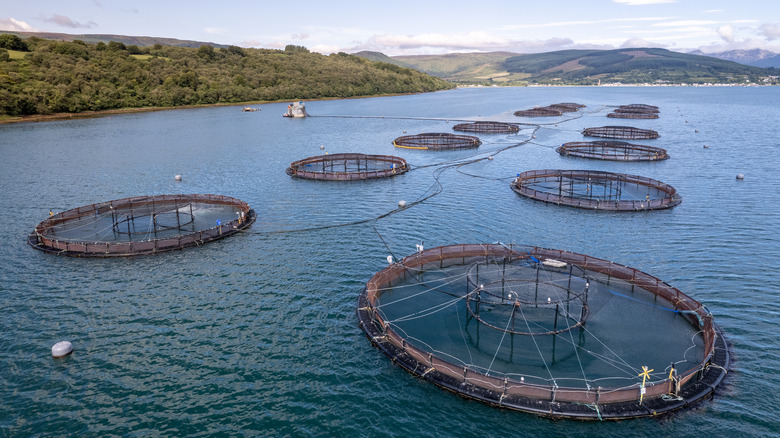The Biggest Misconceptions About Farm-Raised Fish
There may be lots of mixed messages about the health benefits of eating fish and seafood. However, if you're looking for a way to boost nutrition without compromising flavor, adding more fish to your diet is a great solution. It's even a key pillar of the popular Mediterranean diet. The Washington State Department of Health offers a few of the many nutritional benefits that fish can provide, such as increased brain function, enhanced heart health, and reduced inflammation. The presence of omega-3 fatty acids has much to do with its beneficial health effects, with these essential nutrients plentiful in oysters, salmon, canned tuna, and many other varieties of seafood and fish.
When shopping for seafood at your local grocery store, you'll be faced with a few decisions. In addition to deciding between fresh or frozen, you'll also need to choose between wild-caught and farm-raised. According to Colorado State University, wild-caught fish are sourced from lakes, rivers, and oceans, while farm-raised fish are reared in artificial environments, such as tanks or enclosures. Many people swear by the quality of wild-caught seafood, claiming that it's more flavorful and has greater nutritional content. However, there are a few great reasons to choose farm-raised varieties over wild fish.
Consistent, nutritious quality
There are a lot of misconceptions around the farm-raised seafood industry, which is also known as aquaculture (via Explore Animal Health). In terms of nutrition, farm-reared fish are fed a special diet that is designed to provide the maximum nutritional value with the lowest chance of contamination, which is not possible with wild seafood. As a result, aquaculture operations can yield fish with higher levels of omega-3 fatty acids, as well as other essential nutrients. Aquaculture also positively affects the quality of the fish since conditions can be tightly controlled.
Along with the benefits afforded to humans and their diets, fish farms also offer some key environmental benefits. As a sustainable practice, the goal of aquaculture is efficiency. Producers look for ways to generate high yields while using as few resources as possible. Additionally, fish farms are crucial when faced with shortages of fish, which is a very real issue related to sourcing seafood from the wild.
How fish farming benefits the environment
The impact that humanity's taste for seafood can have on the environment is quite shocking (via World Wildlife Fund). Stocks of aquatic wildlife are being rapidly depleted due to overfishing, which is the process of removing more fish from the ocean than can be replaced naturally. For example, the world's obsession with sushi has led to a 97% drop in historic levels of blue tuna. Sourcing fish from the wild also contributes to an issue called bycatching, which is when commercial fishing vessels catch a different species of fish than what they intended. Due to overfishing and bycatching, ⅓ of fishing operations throughout the world are faced with significant shortages.
Per the National Oceanic and Atmospheric Administration Fisheries, aquaculture is an effective solution to overfishing. Some fish farms even benefit natural waterways by replenishing the number of shellfish, which help filter water and stop shorelines from significantly eroding. However, fish farming also offers numerous other benefits that go beyond environmental preservation. Along with the impact on aquatic wildlife, overfishing contributes to food insecurity throughout the globe. Fish farming ensures there's an ample stock of seafood available, particularly in areas where access to wholesome, nutritious food is scarce. The aquaculture industry is also effective at creating new jobs for improved access to gainful employment. Accordingly, making sustainable food choices can have a positive effect on communities and regions around the world.


